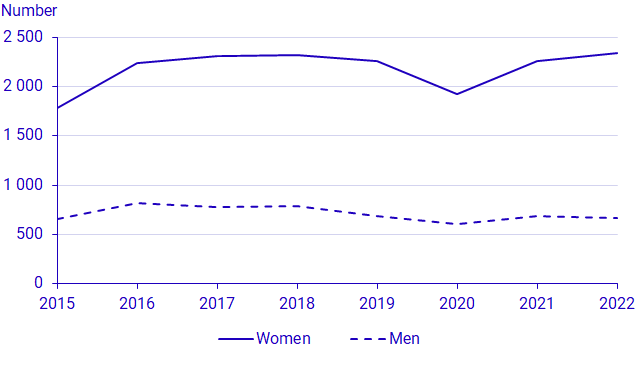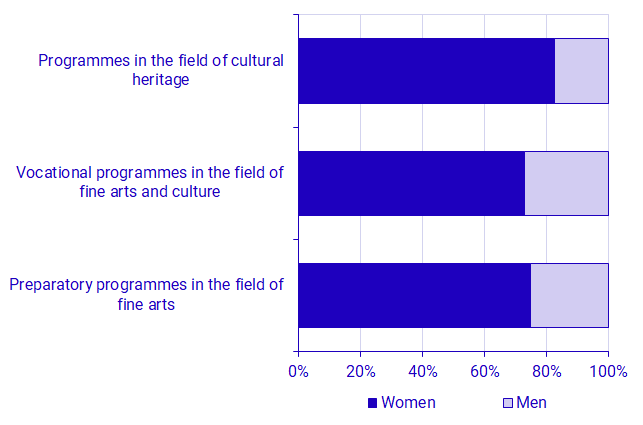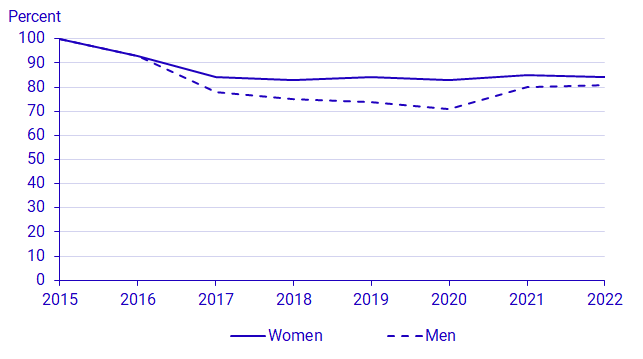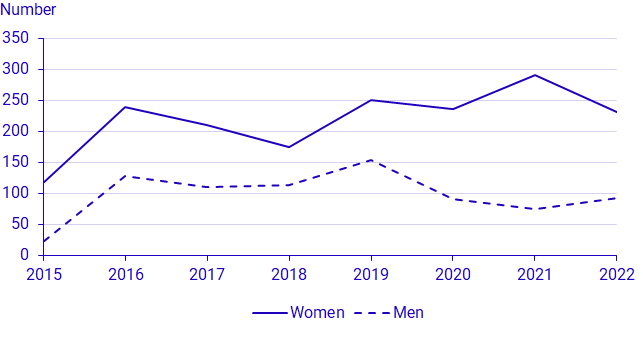Fine arts- and culture programmes and certain other programmes, 2022
More students completed their arts and cultural programmes 2022
Statistical news from Statistics Sweden 2023-05-25 8.00
The number of students who commenced studies in programmes in the fields of arts and culture increased in 2022 compared with previous year. Additionally, the number of students who completed their education also increased and reached the highest number since the programs started in 2015.
Post-secondary programmes in arts and culture have been available since autumn 2015. The programmes are divided into three different types of education with different purposes. Higher education preparatory programmes aim to prepare students for higher education programmes that can lead to an academic degree in the arts. Vocational programmes aim to develop students’ skills in the arts and cultural field. Programmes in the field of cultural heritage aim to train students to conserve and develop cultural heritage.
Major differences between sexes among students in arts and cultural programmes
In 2022, 3 000 admitted students in total commenced studies, which is slightly more than in 2021. Among those who commenced their studies, women are a clear majority. Since 2015, around three-fourths of admitted students who commenced their studies have been women.

Women who commenced their studies in arts and cultural programmes in 2022 are overrepresented in all education types. The largest differences between the sexes are in the programmes in the field of cultural heritage. In this education type, women account for 82 percent of those who commenced their studies in 2022.

The difference in completion rates between sexes has decrease
The completion rate among students in arts and cultural programmes slightly decreased in 2022 compared to 2021 but remains higher than the years 2017-2020. The high completion rate in 2015 can be explained by the fact that there was a smaller number of short programmes in the second half of 2015 in which all students completed their programmes.
Women have a higher completion rate than men, but the difference decreased for the second year in a row. Women had a completion rate of 84 percent, compared with 81 percent for men. This can, in part, be explained by the fact that women to a greater extent enter programmes in the field of cultural heritage. The length of these programmes is generally short, and the completion rate is also higher than for the other education types.

A majority of those who commence studying certain other programmes (programmes with only supervision) is women
The ordinance on support to arts and cultural programmes and certain other programmes also provides an opportunity to conduct programmes under government supervision. These post-secondary school programmes are not covered by economic support in the form of central government grants and the students are not entitled to study allowance. The programmes are conducted in various subject areas, not just in the arts and cultural field. The education orientation covers areas such as fashion design, music, and training for aviation. As different from, for example, higher education vocational programmes, these programmes do not have to match employment needs for qualified labour.
The number of admitted students who commenced studies in certain other programmes (programmes with only supervision) decreased slightly in 2022 to 320 students. Also, in this form of education, a majority of those who commence studies are women.

Definitions and explanations
Official statistics on arts and cultural programmes and certain other programmes
Since 2018, Statistics Sweden has been responsible for official statistics on arts and cultural programmes and certain other programmes (programmes with only supervision).
Statistics on students and on students who complete their studies are based on information from the Swedish National Agency for Higher Vocational Education, which in turn receives the information from the education providers. Persons are counted in each programme session and may therefore be included in the statistics two or more times in the same year. Therefore, the number of admitted students who commenced their studies, students, and students who completed their programmes do not equal the total number of people.
Admitted students who commenced their studies
Admitted students who commenced their studies refers to all persons who are students or who were students during a programme session, including those who joined the programme at a later time and those who dropped out of the programme.
Completion rate
Completion rate is used here to describe the proportion of students who completed their programme. It refers to students who completed the programme, as a proportion of all students who enrolled in the programme modules concluded during one year.
Next publishing will be
Statistics on students and students who complete their studies is scheduled to be published in 2024.
Statistical Database
More information is available in the Statistical Database
Feel free to use the facts from this statistical news but remember to state Source: Statistics Sweden.
